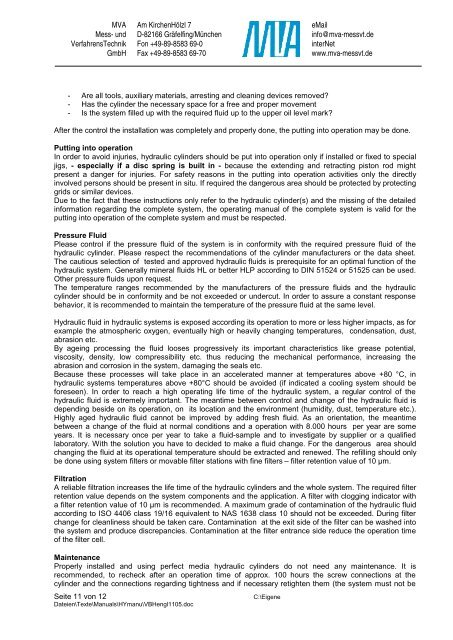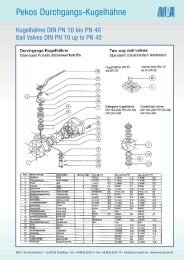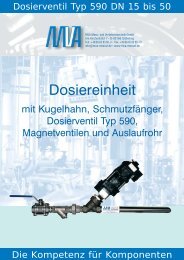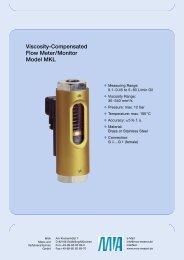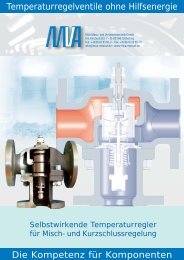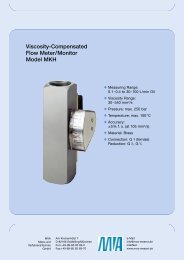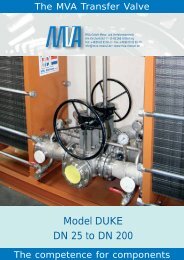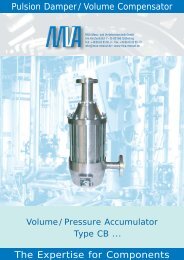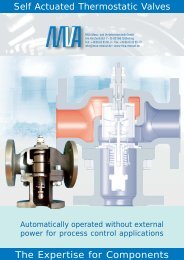Hy Supply Unit - MVA Mess
Hy Supply Unit - MVA Mess
Hy Supply Unit - MVA Mess
Create successful ePaper yourself
Turn your PDF publications into a flip-book with our unique Google optimized e-Paper software.
<strong>MVA</strong><br />
<strong>Mess</strong>- und<br />
VerfahrensTechnik<br />
GmbH<br />
Am KirchenHölzl 7<br />
D-82166 Gräfelfing/München<br />
Fon +49-89-8583 69-0<br />
Fax +49-89-8583 69-70<br />
- Are all tools, auxiliary materials, arresting and cleaning devices removed?<br />
- Has the cylinder the necessary space for a free and proper movement<br />
- Is the system filled up with the required fluid up to the upper oil level mark?<br />
Seite 11 von 12 C:\Eigene<br />
Dateien\Texte\Manuals\HYmanu\VBHengl1105.doc<br />
eMail<br />
info@mva-messvt.de<br />
interNet<br />
www.mva-messvt.de<br />
After the control the installation was completely and properly done, the putting into operation may be done.<br />
Putting into operation<br />
In order to avoid injuries, hydraulic cylinders should be put into operation only if installed or fixed to special<br />
jigs, - especially if a disc spring is built in - because the extending and retracting piston rod might<br />
present a danger for injuries. For safety reasons in the putting into operation activities only the directly<br />
involved persons should be present in situ. If required the dangerous area should be protected by protecting<br />
grids or similar devices.<br />
Due to the fact that these instructions only refer to the hydraulic cylinder(s) and the missing of the detailed<br />
information regarding the complete system, the operating manual of the complete system is valid for the<br />
putting into operation of the complete system and must be respected.<br />
Pressure Fluid<br />
Please control if the pressure fluid of the system is in conformity with the required pressure fluid of the<br />
hydraulic cylinder. Please respect the recommendations of the cylinder manufacturers or the data sheet.<br />
The cautious selection of tested and approved hydraulic fluids is prerequisite for an optimal function of the<br />
hydraulic system. Generally mineral fluids HL or better HLP according to DIN 51524 or 51525 can be used.<br />
Other pressure fluids upon request.<br />
The temperature ranges recommended by the manufacturers of the pressure fluids and the hydraulic<br />
cylinder should be in conformity and be not exceeded or undercut. In order to assure a constant response<br />
behavior, it is recommended to maintain the temperature of the pressure fluid at the same level.<br />
<strong>Hy</strong>draulic fluid in hydraulic systems is exposed according its operation to more or less higher impacts, as for<br />
example the atmospheric oxygen, eventually high or heavily changing temperatures, condensation, dust,<br />
abrasion etc.<br />
By ageing processing the fluid looses progressively its important characteristics like grease potential,<br />
viscosity, density, low compressibility etc. thus reducing the mechanical performance, increasing the<br />
abrasion and corrosion in the system, damaging the seals etc.<br />
Because these processes will take place in an accelerated manner at temperatures above +80 °C, in<br />
hydraulic systems temperatures above +80°C should be avoided (if indicated a cooling system should be<br />
foreseen). In order to reach a high operating life time of the hydraulic system, a regular control of the<br />
hydraulic fluid is extremely important. The meantime between control and change of the hydraulic fluid is<br />
depending beside on its operation, on its location and the environment (humidity, dust, temperature etc.).<br />
Highly aged hydraulic fluid cannot be improved by adding fresh fluid. As an orientation, the meantime<br />
between a change of the fluid at normal conditions and a operation with 8.000 hours per year are some<br />
years. It is necessary once per year to take a fluid-sample and to investigate by supplier or a qualified<br />
laboratory. With the solution you have to decided to make a fluid change. For the dangerous area should<br />
changing the fluid at its operational temperature should be extracted and renewed. The refilling should only<br />
be done using system filters or movable filter stations with fine filters – filter retention value of 10 µm.<br />
Filtration<br />
A reliable filtration increases the life time of the hydraulic cylinders and the whole system. The required filter<br />
retention value depends on the system components and the application. A filter with clogging indicator with<br />
a filter retention value of 10 µm is recommended. A maximum grade of contamination of the hydraulic fluid<br />
according to ISO 4406 class 19/16 equivalent to NAS 1638 class 10 should not be exceeded. During filter<br />
change for cleanliness should be taken care. Contamination at the exit side of the filter can be washed into<br />
the system and produce discrepancies. Contamination at the filter entrance side reduce the operation time<br />
of the filter cell.<br />
Maintenance<br />
Properly installed and using perfect media hydraulic cylinders do not need any maintenance. It is<br />
recommended, to recheck after an operation time of approx. 100 hours the screw connections at the<br />
cylinder and the connections regarding tightness and if necessary retighten them (the system must not be


